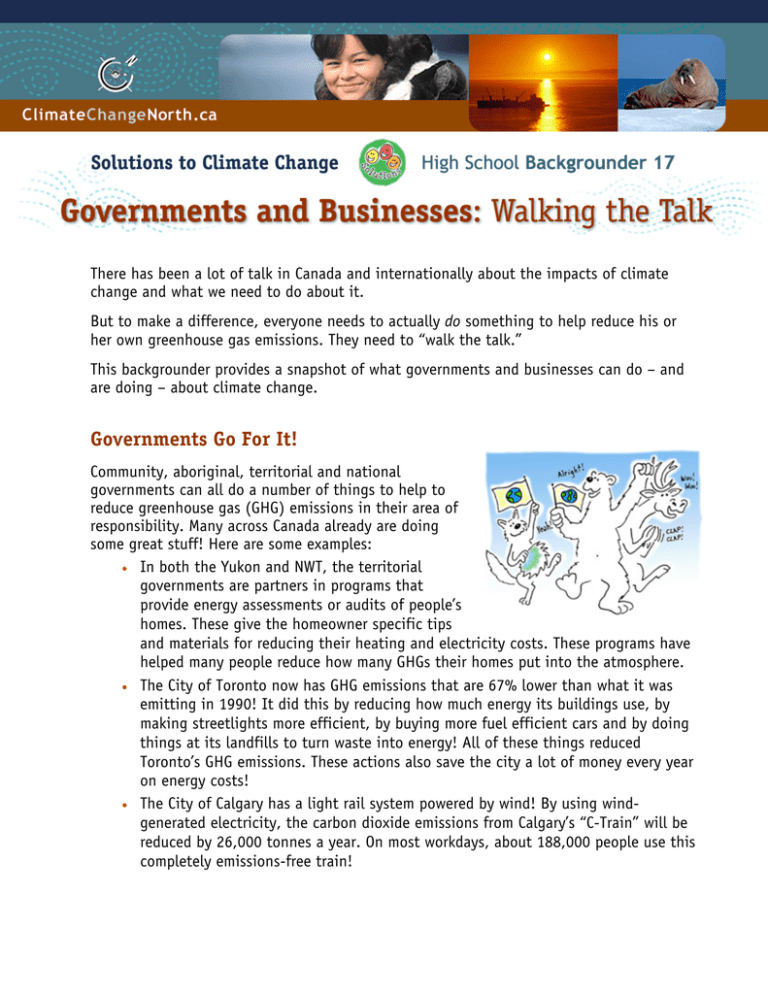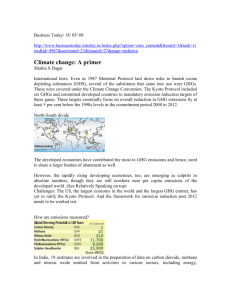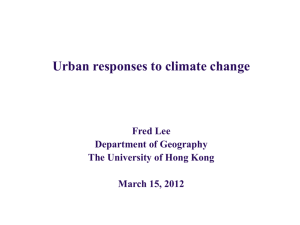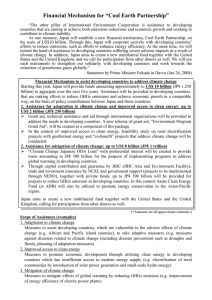There has been a lot of talk in Canada and... change and what we need to do about it.
advertisement

There has been a lot of talk in Canada and internationally about the impacts of climate change and what we need to do about it. But to make a difference, everyone needs to actually do something to help reduce his or her own greenhouse gas emissions. They need to “walk the talk.” This backgrounder provides a snapshot of what governments and businesses can do – and are doing – about climate change. Governments Go For It! Community, aboriginal, territorial and national governments can all do a number of things to help to reduce greenhouse gas (GHG) emissions in their area of responsibility. Many across Canada already are doing some great stuff! Here are some examples: • In both the Yukon and NWT, the territorial governments are partners in programs that provide energy assessments or audits of people’s homes. These give the homeowner specific tips and materials for reducing their heating and electricity costs. These programs have helped many people reduce how many GHGs their homes put into the atmosphere. • The City of Toronto now has GHG emissions that are 67% lower than what it was emitting in 1990! It did this by reducing how much energy its buildings use, by making streetlights more efficient, by buying more fuel efficient cars and by doing things at its landfills to turn waste into energy! All of these things reduced Toronto’s GHG emissions. These actions also save the city a lot of money every year on energy costs! • The City of Calgary has a light rail system powered by wind! By using windgenerated electricity, the carbon dioxide emissions from Calgary’s “C-Train” will be reduced by 26,000 tonnes a year. On most workdays, about 188,000 people use this completely emissions-free train! • • • • • The City of Whitehorse, Yukon diverts food waste, yard waste, scrap paper and even sawdust from going into the dump. If these organic things are put straight into the dump with everything else, they will create methane emissions when they decompose (break down). However, if these organic wastes are separated and turned over frequently with equipment, so that oxygen gets mixed in with the rotting material, then methane is not produced when the stuff rots. Cities like Whitehorse that redirect these organic wastes from the main part of the landfill can turn the piles of waste over with equipment. Breaking down organic waste like this is called composting. The final product, the compost, is like dirt and is full of good nutrients. It can be spread on lawns and gardens to help the plants grow! In Okotoks, Alberta a number of different partners are involved in an interesting housing project. The partners include the town, federal government departments and private businesses. They are building 50 or so new houses in a new subdivision. Each house will have solar heat collectors. The collected heat will be stored deep in the ground during the summer. This heat can then be pulled out of the ground when it’s needed in the winter! In October 1998, the City of Saskatoon constructed a new energy efficient library. By reducing energy use in the building, the city will lower its energy costsby about 50%, a savings of $15,813. At the same time, it will prevent more than 194 tonnes of CO2 a year from being emitted into the atmosphere! In the capital of Nunavut, waste heat from Iqaluit’s power plant will be piped into a new regional hospital that is going to be built in 2004. In 1992, the small Cree First Nation community of Oujé-Bougoumou, Québec (in the James Bay region) installed a village-wide district heating system. This system uses biomass (e.g. wood sawdust) to create heat. By 1997, 135 homes and a number of public buildings were connected to the central boiler through a network of piping. In 1995, biomass provided 85% of the energy used to fuel the system (the rest was oil). Yet the biomass fuel only made up about 15% of the fuel costs because the sawdust is way cheaper than oil. The community received a United Nations award in 1995 for being a “sustainable community.” Backgrounder 17: Governments and Businesses: Walking the Talk ~ 2 These are just a few ways that communities and other governments across Canada are reducing their GHG emissions. Action plans All three territorial governments in Northern Canada have or are working on action plans to reduce GHG emissions in the territories. The federal government of Canada recently released its own action plan called “Climate Change Plan for Canada.” These climate change action plans often outline how the government might reduce its own emissions. For example the government might: • Commit to buying more fuel efficient cars for its own use; • Put some money into making energy improvements to its own buildings; or • Educate its employees so that they turn off their lights and computers when they are not being used. Governments can also provide direction to others on how to reduce their GHG emissions. They can do things to encourage people to take action. They can also take actions to discourage people from pumping GHGs into the atmosphere! For example, territorial and federal governments can: • Increase taxes on things like gas. Higher gas and fuel prices would discourage people from driving as much because it would cost more to drive cars. They could also add taxes to heating fuels so that people would work to improve the energy efficiency of their homes! • Provide tax breaks or funding for research to companies that are developing new, cleaner forms of renewable energy. • Stop financing things that hide the full cost of using oil, gas or diesel. For example, the Government of Nunavut pays for building and upgrading tanks that are used to store diesel. But this cost of storing diesel isn’t factored into the final electricity rates that people pay. If a government is going to finance – subsidize – energy costs, it should finance cleaner, renewable forms of energy. • Educate the public to let people know how they can make their homes more energy efficient or how they can reduce use of their cars and trucks. Backgrounder 17: Governments and Businesses: Walking the Talk ~ 3 Municipal governments can: • Improve public transit, set up carpooling networks or provide bike lanes on the streets to encourage people to use their cars less. • Charge more for parking around town to discourage people from driving into town (maybe they would walk, bike or bus instead!). Get them to walk the talk! Government action plans are really just words on paper. People need to make sure their governments create plans and then do what they say they are going to do! Governments need to “walk” all their “talk”! People like you, your friends and family need to encourage your governments to keep heading down the road to reduced GHG emissions! Governments usually respond to what the public wants. So it is important that people like you let governments know when they are doing a good job on climate change and how you think they could do even better! What are Businesses and Industry Doing? Businesses in your community and around the world can do many of the same things that governments can do to reduce their GHG emissions. Businesses and industry can: • make their buildings more energy efficient; • buy more fuel efficient vehicles; • encourage their employees to take the bus by providing free or cheap bus passes and charging parking fees for those that continue to drive to work; • get employees to turn off lights and computers when not needed; • reduce the waste they send to landfills; • reduce the number of business trips their employees take every year. Backgrounder 17: Governments and Businesses: Walking the Talk ~ 4 Many businesses manufacture things like plastics, cement, iron or other products that we all use. Usually the manufacturing process creates GHG emissions because it involves burning fossil fuels. But there are many ways for these companies to reduce their manufacturing emissions. For example, they can upgrade their equipment so that they use less energy to make things and therefore pump fewer greenhouse gases into the air. Businesses and industry can also try to use renewable forms of energy that produce few or even zero GHGs. This is already happening. Companies around the world are installing solar panels to provide the electricity or hot water for their businesses. Others companies are trying out wind power. Still others are capturing the heat that is given off when they run their factories and using it to heat their buildings. Energy companies (those that produce oil, gas, coal, or electricity) can start spending more money on developing cleaner, renewable forms of energy instead of ones that produce GHGs. Automobile companies can invest in building energy efficient cars and even smaller “neighbourhood” vehicles that are designed for short trips around town. And there are companies all over the world that are doing many of the things listed above. All of their efforts help to reduce how many GHGs they pump out. There are even some companies that will only buy their supplies from other companies that are also working in an environmentally-friendly way. Everyone can do this – we can ask the companies we buy products from to do a better job of reducing their GHG emissions. We can write to companies with suggestions on how they can help to reduce GHG emissions. Also, when we buy products, we can make choices that will help reduce GHGs. For example, we can choose to buy ones that have less packaging because packaging takes energy to create. We can buy items that are produced closer to our communities so less fuel is burned to get them to us. We can try to buy things from companies that are making an effort to reduce their own emissions instead of buying from companies that are doing nothing. Backgrounder 17: Governments and Businesses: Walking the Talk ~ 5 This is the future! Trying to create fewer GHGs might sound like a lot of boring work. But the pressure to deal with climate change is leading to some pretty imaginative activities. For example: Germany is working on an “auto-shuttle” where people drive into a see-through container, turn off their engine, and ride on a railway-like line instead of driving on highways. Denmark is trying out its “Rapid Urban Flexible” (RUF) system. The RUF is an electric vehicle that has wheels for the road and a slot for a monorail. The idea is that smaller or larger RUF vehicles will be able to travel directly from the road onto a monorail. The electric vehicle can go 80 kilometres an hour on the roads and then at least 150 km/h on the monorail. And the batteries that run the RUF on the road are recharged when it is on the monorail. In Ebina Japan, a group of commuters are participating in a pilot project. They travel to and from work in a GHG-free “Hypermini” electric vehicle. During the workday the Hyperminis would normally be sitting in a parking lot. Instead the vehicles are used by city hall staff – for official business. So both the commuters and the City staff are able to use the GHG-free cars and fewer cars have to be produced to meet the need. Inventors in Australia are developing a technology that fits on to a car exhaust pipe. This gizmo, about the size of a wine bottle, heats up the car’s emissions to 5000° Celsius. This high heat breaks down the molecular bonds in the exhaust fumes. The cooled particles can be collected from the tail pipe and treated by another process to create diamonds! No kidding! It is estimated that this new technology should reduce car emissions by 70–80%. Backgrounder 17: Governments and Businesses: Walking the Talk ~ 6 Business Success Stories 1. Interface Inc. is one of the world’s largest carpet companies. It realized that it was using a large amount of fossil fuels to produce its carpets. Interface also realized that once their carpets were worn out – after about ten years of use – the old carpets were taken out and sent to the landfills. So Interface decided to improve how they produced their carpets. They created a “carbon-neutral” carpet tile (meaning it didn’t put any extra GHGs into the atmosphere). The tile was also fully recyclable. Then Interface stopped selling the carpets – they started renting them instead! When a business wears out a rental carpet, Interface takes it away to recycle and make into a new one! And the business gets a new carpet to rent! If Interface had sold the carpet, then the business they sold it to would have been responsible for getting rid of it – the carpet likely would have gone to the dump! By renting out the carpet, Interface is able to take care of its product from the beginning to the end of its life. 2. Mountain Equipment Co-op (MEC) recently built a new store in Ottawa. MEC took recycled materials from its old building and put them together with other efficient building materials to create a very energy efficient building. (They also used some straw bales as insulation!) This store will use about half the energy that a store of the same size in Ottawa would typically use. This means fewer GHGs will be added to the atmosphere. It did cost about 10% more to build than if MEC had used normal construction. However, MEC expects to earn back that extra cost in about 10 to 12 years because they will be paying less for heating and electricity. 3. Pratt and Whitney, a company that builds jet engines, uses 5,000 computers in its offices. It realized that monitors on the computers were consuming a lot of electricity when they were not even being used. By getting people to turn the monitors off, the company saved $234,000 every year and prevented tonnes of carbon dioxide from going into the atmosphere. 4. The Ekati mine in NWT set up an “Operating Excellence” team to lead energy efficiency efforts at the mine. The Operating Excellence team set a goal of reducing the mine’s fuel use by 500,000 litres a year. It asked mine employees for suggestions on how to do this. Within just three weeks of starting the program, the team managed to cut fuel usage by the equivalent of 88,000 litres a year! A great start! The team continues to explore a range of options for reducing energy use at the mine. Backgrounder 17: Governments and Businesses: Walking the Talk ~ 7 Key Points All levels of government can create a climate change action plan to help guide how they will reduce GHGs. Governments can reduce GHGs in their own operations (by buying efficient cars, turning off extra lights, building more efficient buildings). They can also take steps to get the public and businesses to reduce GHGs. Businesses and industry can do many things to reduce their GHG emissions. Many of these things will help them to save money. You can encourage governments and companies to reduce how many GHGs they are adding to the atmosphere. If they do, they will contribute to slowing climate change. Backgrounder 17: Governments and Businesses: Walking the Talk ~ 8 Want to Know More? Check out these websites to find out about all kinds of great new initiatives being taken by governments and businesses: • Climate Change Solutions (Municipalities): http://www.climatechangesolutions.com/municipal/default.shtml?o=intro – Information about what Canadian municipalities could do, and are doing. Be sure to click on ‘Success Stores’ and ‘Opportunity Areas’ along the top. • David Suzuki Foundation: www.davidsuzuki.org/climate_change/Solutions/Green_leaders.asp – Community and company success stories. • Energy Solutions Centre: www.nrgsc.yk.ca – Links to Green Power and Energy Efficiency initiatives in Yukon. • Government of Canada: http://www.climatechange.gc.ca/english/canada – Discusses actions planned by our government • Rocky Mountain Institute: www.rmi.org/sitepages/pid199.php – Interesting case studies of ‘green’ buildings and projects. • Stormy Weather (Solutions Updates): http://www.earthfuture.com/stormyweather/updates/ – All sorts of actions being taken by businesses and governments to combat climate change. Backgrounder 17: Governments and Businesses: Walking the Talk ~ 9





